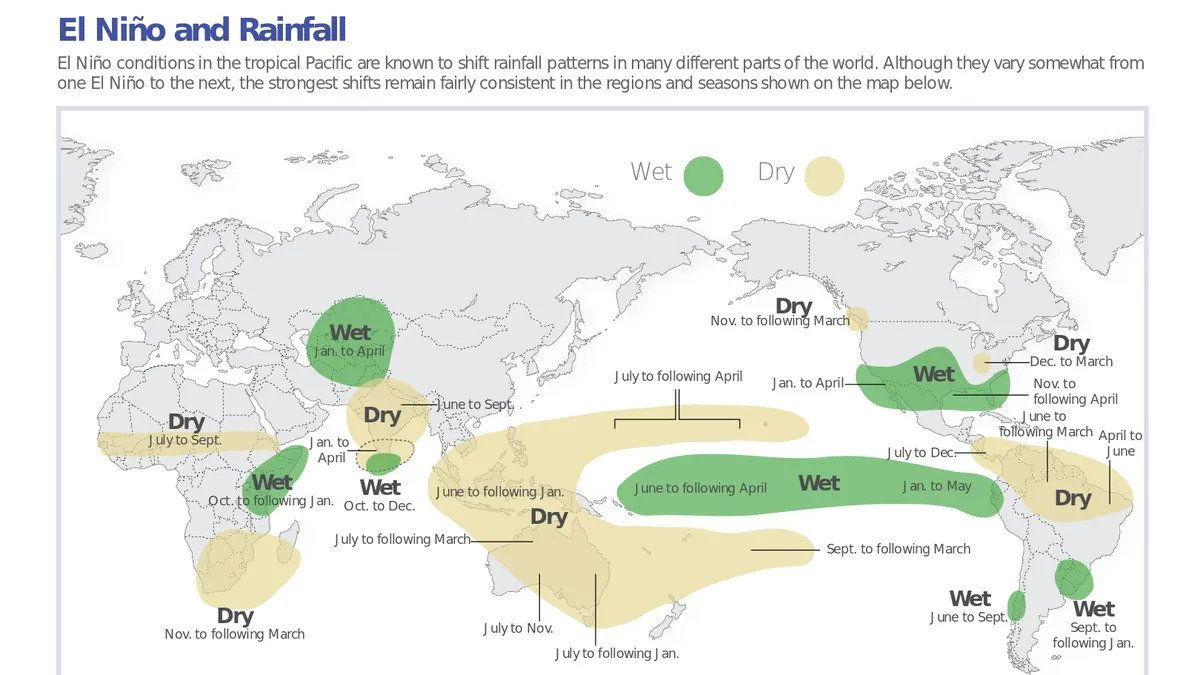El Nino and developing countries: the case of Pakistan


· 4 min read
Less than two months to go before the world steps into the year 2024. If we take Earth as an individual, it has seen a lot in the previous 3 years. Just as it was recovering and recuperating from one of the deadliest pandemics the world has seen in the last 100 years, the Russia-Ukraine war and the ensuing global economic upheaval hit.
Now, the war in the Middle East and the heart-wrenching loss of human life marks the sad ending of 2023. Stepping into 2024, there are many challenges to confront. However, in this article, we are going to talk about the one related to climate: El Nino. Developing countries, like Pakistan, are one of the most vulnerable to these changes.
For those not familiar with El Nino, here is some context: it is part of a wider climatic pattern called El-Nino Southern Oscillation (ENSO). There are two parts to this, one is El Nino and the other one is La Nina. The latter is responsible for global cooling while the former is responsible for warmer temperatures. El Nino entails a rise in sea surface temperatures. As the temperatures rise, it sets in motion unpredictable climate patterns. Areas that are normally dry receive more than expected rainfall and those usually wet experience extremely dry conditions. In both cases, crop yields are adversely impacted (which relates to food security) and catastrophic effects like floods, hurricanes and storms become a norm.

The case of Pakistan is particularly concerning in this regard. The country stands as the 8th most vulnerable to climate change according to the Global Climate Risk Index. It also suffered from extreme floods in 2022 that resulted in an economic loss of $30 bn. Moreover, 33 million people, one-third of the total population, were displaced while 20.6 million required humanitarian assistance. It is important to note that 1.2 million livestock were lost and about 15 percent of rice crop and 40 percent of cotton crop (a key input for the country’s textile industry - the spine of its export sector as it accounts for 60 percent of the earnings) was also lost. As such, the El Nino, or in simple terms the rising of temperatures, put Pakistan in a very precarious situation.
As a nation deeply dependent on agriculture, contributing 20% to its GDP, the regularity of monsoon rains and the potential for El Niño-induced monsoon variability is alarming and crucial. Such variability often translates into diminished monsoon rains, which can severely impact agricultural productivity and lead to acute water shortages. Recently the arrival of cotton to ginning factories has been the lowest in the past 10 weeks.
Moreover, El Niño is notorious for driving up temperatures. In Pakistan, where lethal heatwaves have become increasingly common, a further rise in temperature attributable to El Niño could have catastrophic public health implications. It can also affect the water supply as El Niño events can disrupt the glacial melt in the critical Hindu Kush-Karakoram-Himalayan region, leading to a significant imbalance in water availability. This has the potential to affect not just agriculture but also the generation of hydropower, which is pivotal for the country's energy supply.
Furthermore, when El Niño causes temperatures to rise, all these issues become more pronounced. The grid, already under pressure, has to work even harder to keep up. This can lead to more frequent power outages, which are not only inconvenient but can also have serious economic impacts and affect the quality of life. Additionally, as the demand for electricity goes up, so can the cost, leading to higher electricity bills for consumers.
As such Pakistan should take pre-emptively and pro-active measures, especially on the disaster management side. Pakistan must prioritize immediate climate action, raising awareness and marshaling resources to counteract the impacts of climate change, with a particular focus on critical sectors such as water management, agriculture, and disaster preparedness. There is a pressing need for comprehensive policy measures and legal frameworks dedicated to fostering sustainable practices, bolstering climate resilience, and facilitating a shift towards renewable energy.
International engagement is also crucial, with Pakistan seeking to forge partnerships that enable the exchange of expertise, innovative technologies, and financial support to enhance its climate response strategies. Moreover, the principle of 'climate justice' should be central to these efforts, ensuring that the concerns and challenges of marginalized groups are addressed and that these communities are actively involved in shaping and benefiting from climate action initiatives.
While there have been some heartening measures and the pain of the cost of living crisis is ameliorating, Pakistan needs to simultaneously prepare for 2024 which can be, according to many scientists, the hottest year on earth.
illuminem Voices is a democratic space presenting the thoughts and opinions of leading Sustainability & Energy writers, their opinions do not necessarily represent those of illuminem.
Gokul Shekar

Effects · Climate Change
Simon Heppner

Effects · Climate Change
illuminem briefings

Climate Change · Effects
Mongabay

Climate Change · Effects
Financial Times

Climate Change · Effects
UN News

Effects · Climate Change